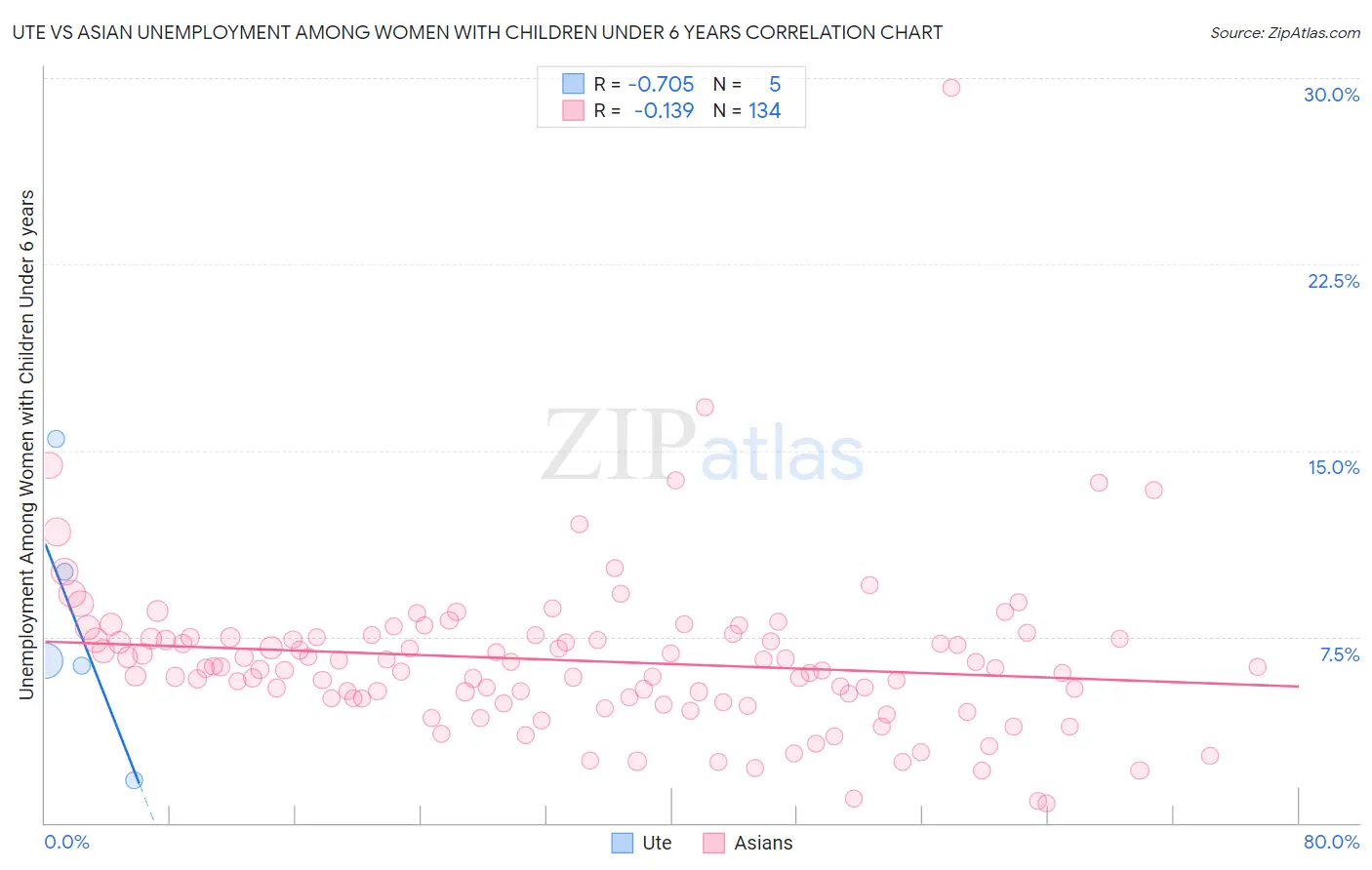Ute vs Asian Unemployment Among Women with Children Under 6 years
COMPARE
Ute
Asian
Unemployment Among Women with Children Under 6 years
Unemployment Among Women with Children Under 6 years Comparison
Ute
Asians
6.5%
UNEMPLOYMENT AMONG WOMEN WITH CHILDREN UNDER 6 YEARS
100.0/ 100
METRIC RATING
20th/ 347
METRIC RANK
6.7%
UNEMPLOYMENT AMONG WOMEN WITH CHILDREN UNDER 6 YEARS
100.0/ 100
METRIC RATING
40th/ 347
METRIC RANK
Ute vs Asian Unemployment Among Women with Children Under 6 years Correlation Chart
The statistical analysis conducted on geographies consisting of 51,284,469 people shows a strong negative correlation between the proportion of Ute and unemployment rate among women with children under the age of 6 in the United States with a correlation coefficient (R) of -0.705 and weighted average of 6.5%. Similarly, the statistical analysis conducted on geographies consisting of 374,627,418 people shows a poor negative correlation between the proportion of Asians and unemployment rate among women with children under the age of 6 in the United States with a correlation coefficient (R) of -0.139 and weighted average of 6.7%, a difference of 3.0%.

Unemployment Among Women with Children Under 6 years Correlation Summary
| Measurement | Ute | Asian |
| Minimum | 1.7% | 0.80% |
| Maximum | 15.5% | 29.6% |
| Range | 13.8% | 28.8% |
| Mean | 8.0% | 6.5% |
| Median | 6.5% | 6.3% |
| Interquartile 25% (IQ1) | 4.0% | 5.0% |
| Interquartile 75% (IQ3) | 12.8% | 7.5% |
| Interquartile Range (IQR) | 8.8% | 2.5% |
| Standard Deviation (Sample) | 5.1% | 3.3% |
| Standard Deviation (Population) | 4.6% | 3.3% |
Demographics Similar to Ute and Asians by Unemployment Among Women with Children Under 6 years
In terms of unemployment among women with children under 6 years, the demographic groups most similar to Ute are Burmese (6.5%, a difference of 0.050%), Immigrants from Korea (6.5%, a difference of 0.47%), Bulgarian (6.5%, a difference of 0.67%), Laotian (6.5%, a difference of 0.82%), and Soviet Union (6.5%, a difference of 0.84%). Similarly, the demographic groups most similar to Asians are Immigrants from Russia (6.7%, a difference of 0.22%), Hmong (6.7%, a difference of 0.28%), Sri Lankan (6.6%, a difference of 0.41%), Luxembourger (6.6%, a difference of 0.67%), and Yakama (6.6%, a difference of 0.74%).
| Demographics | Rating | Rank | Unemployment Among Women with Children Under 6 years |
| Ute | 100.0 /100 | #20 | Exceptional 6.5% |
| Burmese | 100.0 /100 | #21 | Exceptional 6.5% |
| Immigrants | Korea | 100.0 /100 | #22 | Exceptional 6.5% |
| Bulgarians | 100.0 /100 | #23 | Exceptional 6.5% |
| Laotians | 100.0 /100 | #24 | Exceptional 6.5% |
| Soviet Union | 100.0 /100 | #25 | Exceptional 6.5% |
| Cypriots | 100.0 /100 | #26 | Exceptional 6.5% |
| Immigrants | Japan | 100.0 /100 | #27 | Exceptional 6.5% |
| Immigrants | Israel | 100.0 /100 | #28 | Exceptional 6.5% |
| Immigrants | Sweden | 100.0 /100 | #29 | Exceptional 6.6% |
| Immigrants | Belarus | 100.0 /100 | #30 | Exceptional 6.6% |
| Immigrants | Moldova | 100.0 /100 | #31 | Exceptional 6.6% |
| Tsimshian | 100.0 /100 | #32 | Exceptional 6.6% |
| Immigrants | Vietnam | 100.0 /100 | #33 | Exceptional 6.6% |
| Immigrants | South Central Asia | 100.0 /100 | #34 | Exceptional 6.6% |
| Yakama | 100.0 /100 | #35 | Exceptional 6.6% |
| Luxembourgers | 100.0 /100 | #36 | Exceptional 6.6% |
| Sri Lankans | 100.0 /100 | #37 | Exceptional 6.6% |
| Hmong | 100.0 /100 | #38 | Exceptional 6.7% |
| Immigrants | Russia | 100.0 /100 | #39 | Exceptional 6.7% |
| Asians | 100.0 /100 | #40 | Exceptional 6.7% |